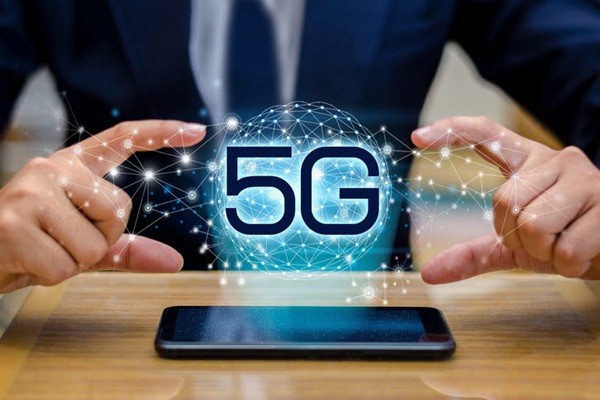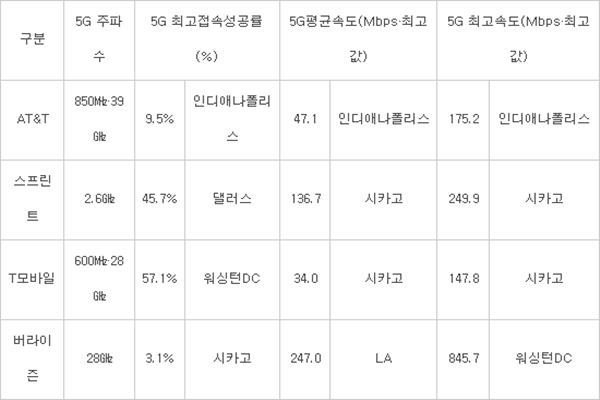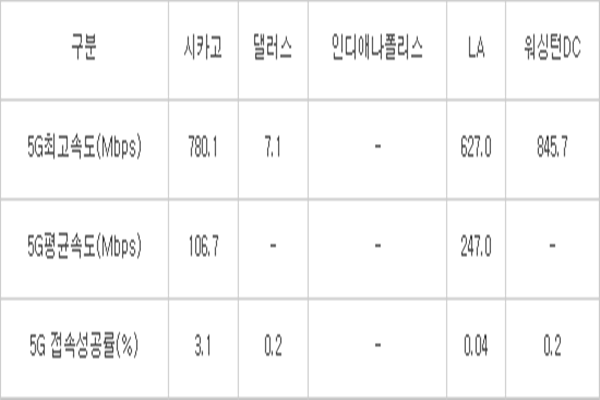It is shown that the access success rate of the 5G network of Verizon, which has commercialized 5G network through 28GHz band that is a high-band millimeter wave (mmWave) frequency, is not even at 3% although the network recorded the highest speed out of 5G networks.
South Korean mobile telecommunications companies are also concerned about their mmWave service models and strategies for building their networks.
A global market research company called RootMetrics showed its findings on the quality of 5G networks of the four major American mobile telecommunications companies. This is the first time the quality of 5G networks based on 28GHz band using 5G smartphone is shown to the public.
RootMetrics evaluated networks in Chicago, Dallas, Indianapolis, Los Angeles (LA), and Washington DC. It used Verizon’s 28GHz band, AT&T’s 850MHz and 39GHz bands, Sprint’s 2.5GHz band, and T-Mobile’s 600MHz and 28GHz bands as the 5G frequency.
Unlike how T-Mobile and AT&T have limited uses of mmWave, Verizon is the only company that has established its 5G network mostly based on 28GHz band.
Verizon’s 5G access success rate recorded 3.1%, 0.2%, and 0.04% in Chicago, Washington DC, and LA respectively. Verizon did not build its 5G network in Indianapolis. T-Mobile’s access success rate was between 22.7% (Dallas) and 57.1% (Washington DC).
Even considering the fact that 5G network is still in its early stage of commercialization in the U.S., Verizon’s 5G access success rate is too low for Verizon’s network to be used in everyday life.
On the other hand, Verizon’s fastest download speed was 845.7Mbps (Washington DC) that was the fastest out of the four companies. Verizon’s average download speed was 245Mbps (LA) and it was also the fastest with Sprint (136.7Mbps) coming at second.

◊South Korean telecommunications companies also concerned about using 28GHz band
“Looking at the quality of Verizon’s 5G network, its mmWave cannot cover one block and is impeded by many obstacles.” said RootMetrics. “However, it has a potential to be a game-changer based on its blazing-fast speed in chaotic places such as stadium and downtown and low delay in remote real-time treatment.”
The result from evaluating the quality of Verizon’s 5G network based on 28GHz band makes many implications for South Korean telecommunications companies that are trying to commercialize 5G networks using 28GHz band. South Korean companies are concerned that their networks will not be useful despite enormous amounts of investments if they do not develop reliable service models.
SK Telecom, KT, and LG Uplus are currently running some tests with relevant equipment makers in order to establish 5G networks based on 28GHz band in the second half of this year.
It is said that their networks’ speed and low delay are outstanding just like American companies’ networks. However, the fact that 28GHz band has weak penetrating power that cannot even go through a glass wall properly has South Korean companies concerned if they can achieve effectiveness compared to how much they invest without any solid service model.
South Korean mobile telecommunications companies have decided on having 28GHz band at the center of hot spot. However, they have yet to decide on the service model or the direction of their strategies.
In case of Verizon, it has yet to present a clear service model besides replacing FWA (Fixed Wireless Access) with wired access using 28GHz network.
In addition to finding a service model, it is expected that technology will be a key to commercializing 28GHz network. It is suggested that telecommunications companies will need to examine whether there are elements such as “beamforming” technology and regulations that can expand their coverages.
“We have yet to finalize on the roadmap for 28GHz band as we lack confidence towards service model.” said a representative for a South Korean mobile telecommunications company. “Even when we commercialize 28GHz networks, they will probably start as incredibly limited models early on.”
Staff Reporter Park, Jisung | jisung@etnews.com

